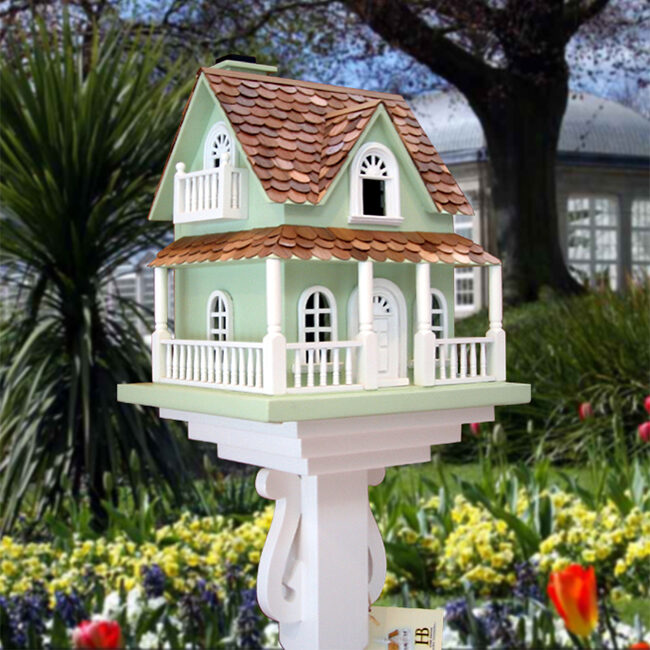Are you looking to add charm to your garden while inviting the soothing sounds of nature? Outdoor decorative birdhouses are a delightful addition that can transform your outdoor space into a haven for birds and a visual treat for yourself. In this guide, I will share my personal experiences, helpful tips, and everything you need to know about selecting, using, and enjoying birdhouses in your backyard.
What Are Outdoor Decorative Birdhouses?
Outdoor decorative birdhouses are specially designed structures that offer shelter for birds while adding aesthetic appeal to gardens, yards, and patios. Unlike standard birdhouses, these come in various artistic designs, colors, and sizes, making them as much of a decorative piece as a functional home for birds.
Benefits of Using Decorative Birdhouses
1. Attracting Birds
One of the primary benefits of birdhouses is their ability to attract a variety of bird species. By providing a safe and cozy environment, you can invite feathered friends into your garden.
2. Enhancing Garden Aesthetics
Birdhouses come in numerous designs that can complement your landscaping. From whimsical to rustic styles, a decorative birdhouse can be a focal point in your garden.
3. Educational Opportunities
Setting up birdhouses can be a fantastic way to engage children or new bird enthusiasts in observing and learning about local wildlife.
4. Encouraging Biodiversity
By providing homes for birds, you contribute to local ecosystems, promoting biodiversity in your neighborhood.

Choosing the Right Birdhouse
Selecting the right birdhouse is crucial for attracting your desired bird species. Here are some factors to consider:
1. Size and Dimensions
The size of the birdhouse should match the type of birds you wish to attract. For example, wrens prefer smaller openings, while bluebirds need a larger entrance.

2. Material
Wood, metal, and composite materials are common. Wood is often preferred for its natural insulation properties.
3. Drainage and Ventilation
Birdhouses should have drainage holes to prevent water accumulation and ventilation holes to keep the interior comfortable.

4. Design
Choose a design that fits your garden’s theme. Some popular styles include:
- Rustic wood
- Brightly painted whimsical styles
- Cottage or Victorian styles
- Modern minimalist designs

Popular Birdhouse Styles
Let’s explore some of the most popular birdhouse styles available:
1. Traditional Wooden Birdhouses
These are typically made from untreated cedar or pine, offering a classic look that blends well with nature.
2. Hand-painted Birdhouses
Artists often create unique pieces that can serve as a stunning garden ornament and functional birdhouse.

3. Recycled Birdhouses
These eco-friendly options utilize materials like old wood, tin cans, and other recycled items to create attractive bird habitats.
4. Vertical Birdhouses
A modern twist, vertical designs save space and can be visually striking.

Where to Place Your Birdhouse
Placement is crucial for attracting birds. Here are some tips based on my experience:
1. Location
Position your birdhouse at least 5-10 feet above the ground in a sheltered spot, away from strong winds and direct sunlight.
2. Focal Points
Consider placing birdhouses near flower beds or water sources, giving birds a natural attraction point.
3. Avoiding Predators
Ensure that the area is safe from potential predators, such as cats and raccoons, by keeping the entrance hole well above reach.
DIY Decorative Birdhouse Ideas
Creating your own birdhouse can be a rewarding project. Here’s a simple guide to get started:
Materials Needed
- Wood (cedar or plywood)
- Wood glue or nails
- Paint or wood stain
- Sandpaper
- Drill with a drill bit for the entrance hole
Basic Construction Steps
- Cut the wood into six panels: front, back, two sides, roof, and base.
- Drill an entrance hole in the front panel.
- Assemble the panels using glue or nails.
- Sand the edges to smooth them out.
- Paint or stain the birdhouse for weather resistance and aesthetics.
- Allow it to dry completely before placing it outside.
Maintenance and Care for Your Birdhouse
To ensure your birdhouse remains a safe haven for birds, proper maintenance is essential:
1. Regular Cleaning
Clean the inside of the birdhouse every spring to remove old nesting materials and debris.
2. Inspect for Damage
Check for cracks, holes, or signs of wear and repair them as necessary to extend the life of the birdhouse.
3. Protect from Pests
Consider adding protective measures like predator guards and keeping the birdhouse away from easily accessible locations for unwanted animals.
Comparison Table of Popular Birdhouse Materials
| Material | Pros | Cons |
|---|---|---|
| Wood | Natural insulation, aesthetic appeal | Can decay if untreated |
| Metal | Durable, weather-resistant | Can overheat, limited aesthetic options |
| Composite | Long-lasting, low maintenance | Can be more expensive |
FAQs About Outdoor Decorative Birdhouses
1. What birds can I attract with decorative birdhouses?
Many species including wrens, chickadees, bluebirds, and finches can be attracted, depending on the style and size of the birdhouse.
2. How often should I clean my birdhouse?
It’s best to clean your birdhouse at least once a year, preferably in early spring before the nesting season begins.
3. Can I leave my birdhouse out in winter?
Yes, leaving it outside helps birds find shelter during winter. Just ensure it’s in good repair and cleaned out.
4. How do I know if my birdhouse is being used?
Look for nesting materials, and listen for chirping sounds in the spring. You may also see birds frequently entering and exiting.